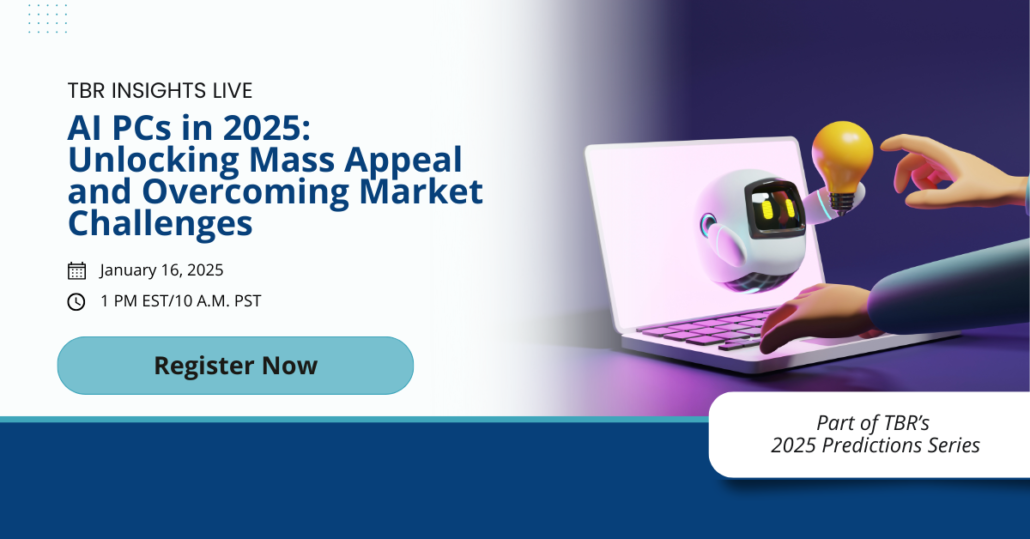Snowflake’s AI Evolution: Scaling Innovation with a Data-first Strategy
TBR attended two virtual Snowflake events in January, AI + Data Predictions 2025: How Operationalizing AI Will Drive Technical Advances and Leadership Challenges on Jan. 16, and Snowflake GenAI Day on Jan. 22. During the events we heard from Snowflake leaders, including Chase Ginther, principal architect AI/ML, and Caleb Baechtold, principal AI architect, Applied Field Engineering. These discussions, coupled with keynote speakers, breakout sessions, and TBR’s ongoing analysis of Snowflake’s strategy, underscore the company’s ongoing transformation from a data warehouse innovator to a leader in integrated data and AI platforms.
Snowflake in transition: Scaling AI through a data-first approach
Snowflake’s AI strategy is centered on a data-first approach that leverages the company’s data management strengths to drive development of advanced AI capabilities. Three key aspects of Snowflake’s strategy help it stand out in a highly competitive data and AI platform market.
First, the company is leveraging its origins as a data warehouse provider to offer a fully integrated data and AI platform. By prioritizing the management of structured and unstructured data, Snowflake enables AI-driven analytics, machine learning (ML) workflows and advanced processing within a unified ecosystem. Second, Snowflake is using advanced technologies to scale its AI capabilities, including GPUs to accelerate ML workloads; Snowflake Container Services (SCS) for efficient model deployment; and Snowpark, which enables seamless AI development using SQL, Python and Java. Third, Snowflake is enhancing its ecosystem through open-source AI collaborations via Cortex, integrating models from Meta, Hugging Face and Mistral to power natural language processing, predictive analytics and automation — all within a secure, data-centric framework. By prioritizing data as a foundation for AI, Snowflake enables efficient scaling while ensuring security, performance and governance within its ecosystem.
During the Snowflake events, TBR observed that customer demand for scalable, governed and actionable data remains a key driver of Snowflake’s evolution. The company’s ability to manage and harmonize disparate data types was repeatedly emphasized. For example, Ginther highlighted Nissan’s success in using Snowflake to analyze millions of customer profiles across multiple markets. This initiative showcased Snowflake’s ability to address complex, large-scale data challenges while delivering actionable insights for decision making.
Generative AI: Unleashing untapped potential beyond chatbots
Snowflake’s scalability is not just about performance; it also plays a critical role in empowering AI adoption through a favorable cost-to-value alignment. The platform’s pay-as-you-go pricing model adjusts to the dynamic demands of AI applications, particularly for resource-heavy use cases such as generative AI (GenAI) and predictive modeling. This flexible model enables organizations to efficiently grow their AI workloads and lowers the barrier to implement advanced AI solutions.
During Snowflake GenAI Day, the company showcased GenAI’s vast potential beyond traditional applications like chatbots and content generation. For example, Snowflake partner Sigma Computing demonstrated how Snowflake transformed raw Salesforce data into actionable insights. The AI-driven analytics not only improved decision making for Sigma’s business leaders but also reduced the time spent on manual data preparation, unlocking faster, more informed outcomes.
However, as enterprises scale their GenAI applications, they face challenges related to data bias, IP risks and ethical AI. To build trust with customers, vendors must design their AI solutions with governance, fairness and transparency in mind to ensure responsible AI deployment. Customers need to implement strong data governance practices that carefully monitor data to avoid perpetuating inaccurate or discriminatory outcomes.
Golden datasets and the future of AI development
One emerging trend highlighted during Snowflake GenAI Day was golden datasets — curated collections of structured and unstructured data optimized for GenAI use cases. These datasets, when enriched by Snowflake’s platform, empower organizations to drive more accurate and impactful AI outcomes. Moreover, Snowflake’s focus on text-to-language prompts, which simplify data interactions by reducing reliance on complex SQL queries, demonstrate its commitment to improving user experiences. Using Snowflake’s Universal Search offering, customers can identify datasets in their accounts based on data quality and usage within their workflows to create optimized — or golden — datasets. Universal Search ensures that users — regardless of their level of technical expertise — can effectively leverage Snowflake’s capabilities for AI development, analytics and decision making. However, building and maintaining golden datasets pose significant challenges. For many organizations, curating and cleaning data at scale require advanced governance frameworks and skilled teams to ensure data quality, relevance and accuracy. Organizations that lack these capabilities may struggle to derive meaningful insights from their AI models. Additionally, errors or inconsistencies in golden datasets can lead to biased outcomes, undermining trust in AI-driven decision making.
Simplifying user interactions
Another topic highlighted during the GenAI Day event was Snowflake’s focus on improving user accessibility. By incorporating text-to-language prompts into its data and AI platform, Snowflake has reduced the technical barrier for users who may lack expertise in SQL or other programming languages. This feature ensures that nontechnical users can interact with the platform effectively, making data-driven insights accessible across diverse teams.
Predictions for 2025: From experimentation to enterprise-grade AI
During the AI + Data Predictions 2025 event, Snowflake forecast a significant shift in AI adoption as enterprises transition from experimental pilots to fully realized, enterprise-grade AI solutions throughout 2025. However, TBR’s 2H24 Cloud Infrastructure & Platforms Customer Research survey results suggest that the adoption of GenAI solutions may progress more slowly than expected in 2025, primarily due to cost constraints and a lack of technical expertise with the emerging technology. Despite these challenges, Snowflake anticipates AI adoption will be driven by AI observability, as businesses increasingly need to prioritize ROI measurement, deployment reliability and regulatory compliance.
During the presentation, speakers discussed how Snowflake’s key AI advancements such as embedding models to enhance the performance of large language models, including GPT models, are enabling task-specific customizations, improving multilingual capabilities and optimizing overall model performance. Snowflake’s platform supports these efforts with containerized runtimes like Snowflake Notebooks and Snowflake Container Services (SCS), which provide scalable and efficient tools for AI development. Baechtold emphasized the critical role of robust datasets in supporting both GenAI and traditional ML models. Snowflake’s platform addresses key challenges, such as data security, governance and accessibility, ensuring enterprises can confidently deploy AI solutions across industries ranging from healthcare to manufacturing.
Deep dive into generative AI’s impact on the cloud market in 2025 in the below TBR Insights Live session
Security, governance and containerization: Building trust in AI
Throughout both events, security and governance emerged as central themes in Snowflake’s AI strategy. As enterprises increasingly integrate multiple platforms and environments, the risk of data breaches and compliance violations grows. Snowflake’s approach to governance includes developing best practices around securing cloud configurations, authenticating model access, and monitoring runtime environments to ensure its AI solutions are scalable, secure and compliant with evolving regulations. For example, OM1’s use of Snowflake demonstrated how containerized systems streamline governance processes and enhance scalability and efficiency. By leveraging these systems, Snowflake ensures that clients can deploy AI solutions with confidence, knowing their data and models are protected.
Despite Snowflake’s efforts, managing security and governance at scale is an ongoing challenge. Customers operating in highly regulated sectors, such as finance or healthcare, may require additional customizations to ensure they comply with stringent regulatory requirements. Additionally, scaling governance frameworks to accommodate rapidly evolving AI use cases could stretch Snowflake’s platform and resources. Providing consistent, enterprise-grade support while maintaining innovation will be essential for Snowflake to navigate these challenges.
Snowflake’s road map: Scaling innovation while meeting enterprise needs
Looking ahead, Snowflake will continue to focus on expanding its integrated data and AI platform while maintaining its core pillars of scalability, flexibility and observability. The company’s ability to bridge the gap between structured and unstructured data — combined with its investments in user experience, embedding models and AI observability —will place it among the leaders in the next wave of AI innovation.
However, Snowflake’s success will depend on its ability to balance innovation with governance, ensuring enterprises can address their unique data challenges while meeting compliance requirements. By focusing on empowering users, streamlining AI deployments and scaling advanced technologies, Snowflake will be well positioned to meet the demands of a rapidly evolving market.
Conclusion
Snowflake’s evolution reflects its commitment to advancing AI through a data-first approach. By addressing the complexities of modern data ecosystems and aligning its platform with emerging AI trends, Snowflake has established itself as a key player in the AI landscape. This strategic focus not only drives digital transformation but also shapes the competitive dynamics of the market, impacting partners, competitors and technology providers. The company has expanded its GenAI capabilities by integrating open-source models such as those from Hugging Face and Meta, enabling customers to deploy and customize AI models more easily.
Snowflake also emphasizes AI observability, providing businesses with tools to track performance, optimize outcomes and ensure ROI, while mitigating model drift. Its governance framework ensures regulatory compliance, safeguarding AI data and models across industries. Snowflake’s efforts to simplify the user experience and make AI more accessible to nontechnical users align with new industry standards. By lowering technical barriers, Snowflake is enabling a broader range of businesses to leverage AI and encouraging the market to innovate toward more user-friendly solutions. However, Snowflake faces challenges in integrating diverse data environments and maintaining data quality at scale. The need for significant infrastructure investments, such as GPUs, may also become a hurdle as AI adoption expands.
As GenAI and AI observability evolve, Snowflake’s integrated platform is positioned to support partners and stakeholders in navigating the next phase of industry transformation. By offering scalable and secure AI workflows, Snowflake is helping them tackle the challenges of adopting AI at scale across industries. TBR will continue monitoring Snowflake’s progress and its influence on AI-driven business strategies across sectors.




